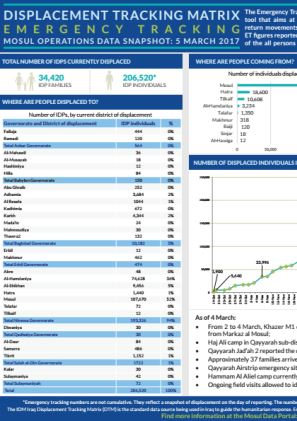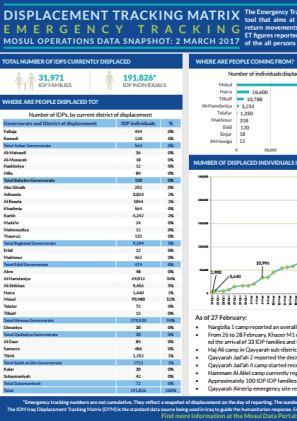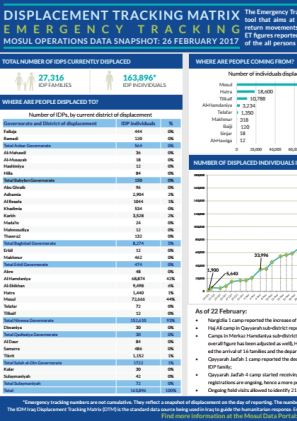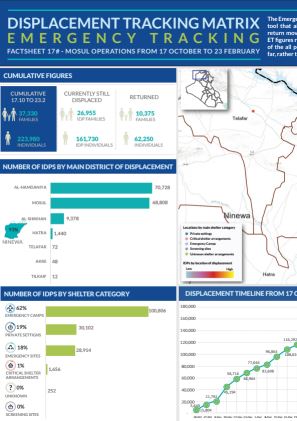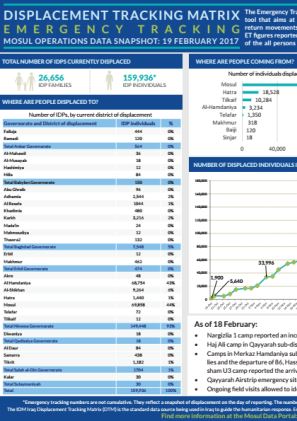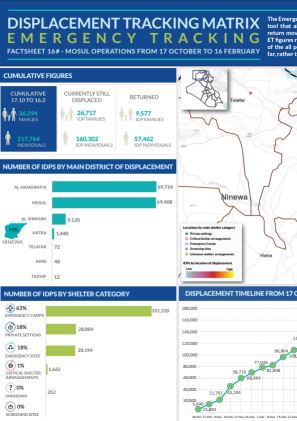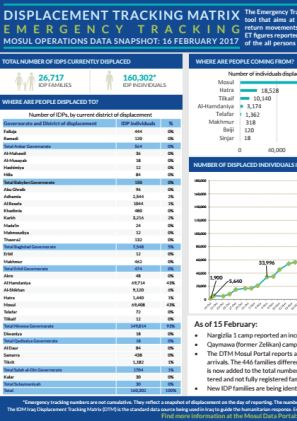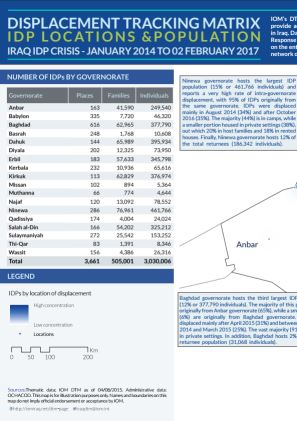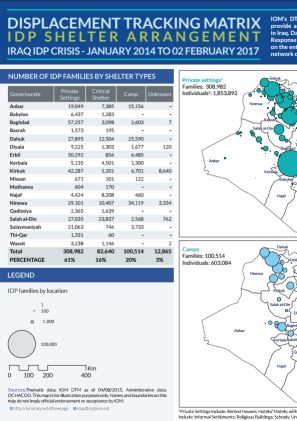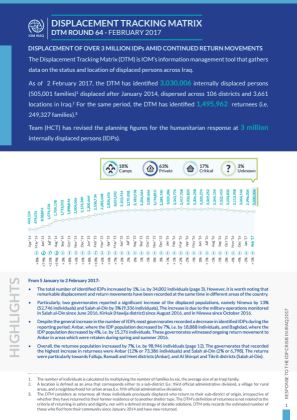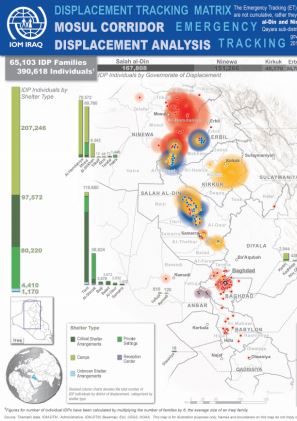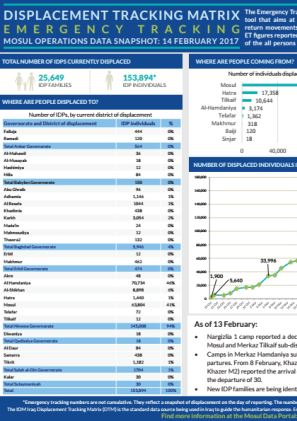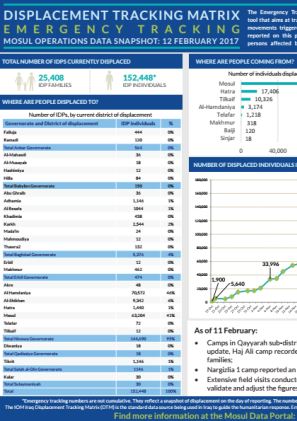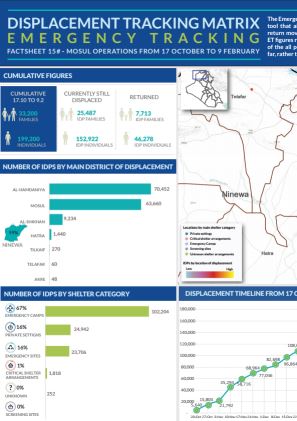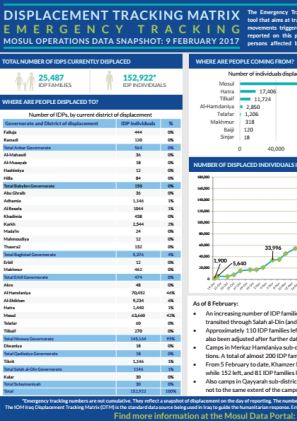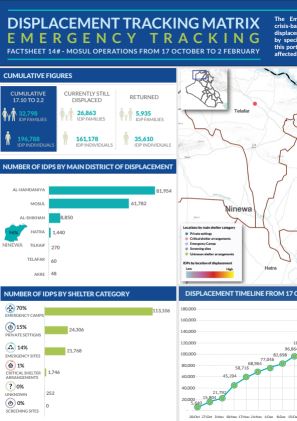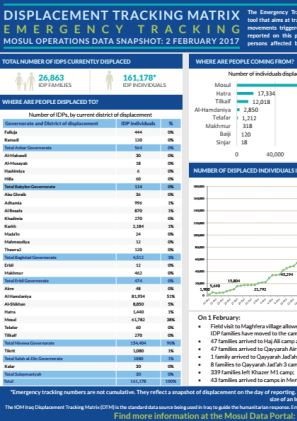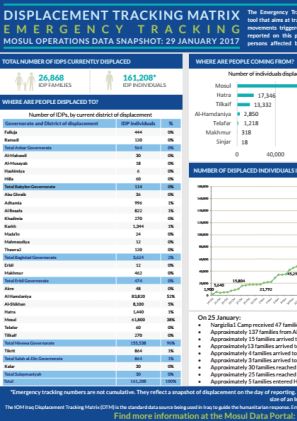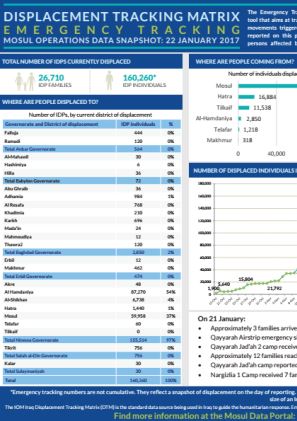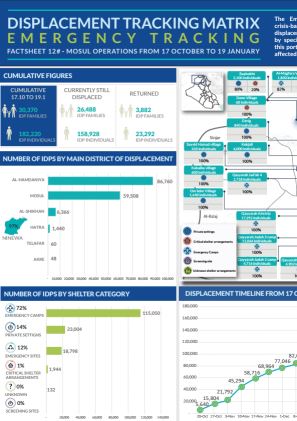-
Countries
-
Data and Analysis
-
Special Focus
-
Crisis Responses
Iraq
IDPs tracked
Displacement Movements
1,124,000
IDMC 2023
Data collection round
About Iraq
Reinforced in January 2014 in response to the need for information on displacement linked to the worsening armed conflict, the DTM programme in Iraq collects key information on internally displaced persons (IDPs) and returnees through different components and methodologies across the entire country.
Through IOM's Rapid Assessment and Response Teams (RARTs) -composed of 140 field staff- present throughout the Iraqi territory, the DTM collects data on numbers and locations of IDPs and returnees using an extended network of over 4,000 key informants. In addition to information collected from key informants, identified locations hosting IDPs are then visited and directly assessed by the RARTs to collect more detailed and in-depth information on the displaced population.
Please visit the Access to Durable Solutions among IDPs in Iraq
Iraq — Mosul Operations Data Snapshot (5 March 2017)
DTM recorded 206,520 IDPs comprising 34,420 families. The highest number of IDPs was recorded in Ninewa governorate (201,594 individuals) which hosts 94% of the IDP population. 171,912 individuals were recorded living in camps and emergency sites.
Iraq — Mosul Operations Data Snapshot (2 March 2017)
DTM recorded 191,826 IDPs comprising 31,971 families. The highest number of IDPs was recorded in Ninewa governorate (179,520 individuals) followed by Baghdad governorate (9,294individuals). 158,238 individuals were recorded living in camps and emergency sites.
Iraq — Mosul Operations Data Snapshot (26 February 2017)
DTM recorded 163,896 IDPs comprising 27,316 families across 7 governorates. The governorate of Ninewa hosted the most IDPs, 152,610 (93%). Mosul was the most commonly cited district of origin with 129, 456 people recorded as originating from there.
Iraq — Emergency Tracking Factsheet 17 (23 February 2017)
The cumulative total of individuals displaced within this period was 161,955 (26,955 families). The district hosting the largest number of IDPs within this period was Al-Hamdaniya with 70,728 recorded IDPs.
Iraq — Mosul Operations Data Snapshot (19 February 2017)
DTM recorded 159,936 IDPs comprising 26,656 families across 7 governorates. The governorate of Ninewa hosted the most IDPs, 149,448 (93%). Mosul was the most commonly cited district of origin with 126,084 people recorded as originating from there.
Iraq — Emergency Tracking Factsheet 16 (16 February 2017)
The cumulative total of individuals displaced within this period was 217,764 (36,294 families). The district hosting the largest number of IDPs within this period was Al-Hamdaniya with 69,714 recorded IDPs.
Iraq — Mosul Operations Data Snapshot (16 February 2017)
DTM recorded 160,302 IDPs comprising 26,717 families across 7 governorates. The governorate of Ninewa hosted the most IDPs, 149,814. Mosul was the most commonly cited district of origin with 126,642 people recorded as originating from there.
Iraq — IDP Locations and Populations (February 2017)
From the start of January 2014 through 2 February 2017, the DTM identified 3,030,006 internally displaced individuals (505,001 families). This map shows locations where IDPs were residing, as well as overall concentrations across the country.
Iraq — IDP Shelter Arrangement (February 2017)
From the start of January 2014 through 2 February 2017, the DTM identified 3,030,006 internally displaced individuals (505,001 families). This map shows the size of IDP population residing in 3 main shelter categories (private, critical, camp plus unknown).
Feb 15 2017
Iraq — IDP Shelter Arrangement (February 2017)
Iraq — Displacement Report 64 (February 2017)
As of 2 February, the DTM has identified 3,030,006 IDPs since January 2014, dispersed across 106 districts and 3,661 locations in Iraq. During this same period DTM has also identified 1,495,962 returnees.
Feb 15 2017
Iraq — Displacement Report 64 (February 2017)
Iraq — Emergency Tracking Mosul Corridor Displacement Analysis (13 February 2017)
The DTM recorded 390,618 IDPs comprising 65,103 families. The majority of the displaced population, 153,006 are within the Mosul area.
Iraq — Mosul Operations Data Snapshot (14 February 2017)
DTM recorded 153,894 IDPs comprising 25,649 families. The governorate of Ninewa hosted the most IDPs, 145,008 (94%). Mosul was the most commonly cited district of origin with 120,900 people recorded as originating from there.
Iraq — Mosul Operations Data Snapshot (12 February 2017)
DTM recorded 152,448 IDPs comprising 25,408 families. The governorate of Ninewa hosted the most IDPs, 144,690 (95%). Mosul was the most commonly cited district of origin with 119,868 people recorded as originating from there.
Iraq — Emergency Tracking Factsheet 15 (9 February 2017)
The cumulative total of individuals displaced within this period was 199,200 comprised of 33,200 families. The district hosting the largest number of IDPs within this period was Al-Hamdaniya with 70,452 recorded IDPs.
Iraq — Mosul Operations Data Snapshot (9 February 2017)
DTM recorded 152, 922 IDPs comprising 25,487 families during this period. The majority of IDPs (119,280) reported that Mosul was their district of origin.
Iraq — Emergency Tracking Mosul Corridor Displacement Analysis (7 February 2017)
The DTM recorded 391,860 IDPs comprising 65,310 families. The majority of the displaced population, 154,932, originated from the districts of Salah-al-Din and Ninewa.
Iraq — Mosul Operations Data Snapshot (7 February 2017)
Within the period DTM recorded 153,714 IDPs comprising 25,619 families. Most IDPs, 119,370, originated from Mosul. The governorate of Ninewa hosted the most IDPs (146,556) within the period. Most IDPs, 127,224 were resident in camps or emergency sites.
Iraq — Mosul Operations Data Snapshot (5 February 2017)
DTM recorded 161,886 IDPs comprising 26,981 families across 7 governorates. The governorate of Ninewa hosted the most IDPs, 155,058. Mosul was the most commonly cited district of origin with 127,902 people recorded as originating from there.
Iraq — Emergency Tracking Factsheet 14 (2 February 2017)
The cumulative total of individuals displaced within this period was 196,788. These comprised 32,798 families. The district hosting the largest number of IDPs within this period was Al-Hamdaniya with 81,954 recorded IDP’s. 70% of the cumulative total of IDPs were living in emergency camps.
Iraq — Mosul Operations Data Snapshot (2 February 2017)
DTM recorded 161,178 IDPs comprising 26,863 families across 7 governorates. The governorate of Ninewa hosted the most IDPs, 154,404. Mosul was the most commonly cited district of origin with 127,308 people recorded as originating from there.
Iraq — Mosul Operations Data Snapshot (29 January 2017)
DTM identified 26,868 IDP families comprised of 161,208 individuals. The majority of the identified individuals (126,126) originated from Mosul. 134,802 people were living in camps/emergency settings and 24,600 people were living in private settings.
Iraq — Emergency Tracking Factsheet 13 (26 January 2017)
DTM recorded a cumulative total of 187,986 IDP’s and 28,980 returnees within this period. 98% of the IDPs are displaced within the district of Ninewa. 71% are in emergency camps, 15% are in private accommodation, 13% are at emergency sites.
Iraq — Mosul Operations Data Snapshot (22 January 2017)
DTM identified 26,710 IDP families comprised of 160,260 individuals. The majority of the identified individuals (127,452) originated from Mosul. 135,720 people were living in camps/emergency settings and 22,794 people were living in private settings.
Iraq — Emergency Tracking Factsheet 12 (19 January 2017)
Currently 26,488 families remain displaced (158,928 individuals). 3,882 families (32,292 individual IDPs) have returned. Between the updates of 12 and 19 January, Mosul district recorded an increase of 28% in the number of IDPs.
Pagination
Pagination
- First page
- Previous page
- …
- 5
- 6
- 7
- 8
- 9
- 10
- 11
- 12
- 13


